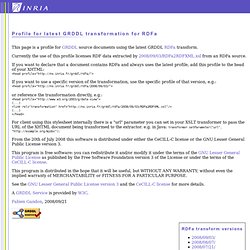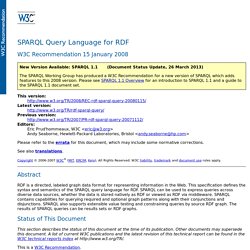

Markjspivey on Twitter: "as #xapi augments itself with #semtech, systems will be challenged by open-world versus closed-world reasoning" Wes Williams - Ramblings on software development. w3. Profile for latest GRDDL transformation for RDFa. This page is a profile for GRDDL source documents using the latest GRDDL RDFa transform.

Currently the use of this profile licenses RDF data extracted by 2008/09/03/RDFa2RDFXML.xsl from an RDFa source. If you want to declare that a document contains RDFa and always uses the latest profile, add this profile to the head of your XHTML: <head profile=" If you want to use a specific version of the transformation, use the specific profile of that version, e.g.: <head profile=" or reference the transformation directly, e.g.: <head profile=" (...) <link rel="transformation" href=" (...) For client using this stylesheet internally there is a "url" parameter you can set in your XSLT transformer to pass the URL of the XHTML document being transformed to the extractor. e.g. in Java: transformer.setParameter("url", " From the 20th of July 2008 this software is distributed under either the CeCILL-C license or the GNU Lesser General Public License version 3.
A GRDDL Service is provided by W3C. Wes Williams - Ramblings on software development.
RDF - Semantic Web Standards. Overview RDF is a standard model for data interchange on the Web.

RDF has features that facilitate data merging even if the underlying schemas differ, and it specifically supports the evolution of schemas over time without requiring all the data consumers to be changed. RDF extends the linking structure of the Web to use URIs to name the relationship between things as well as the two ends of the link (this is usually referred to as a “triple”). Using this simple model, it allows structured and semi-structured data to be mixed, exposed, and shared across different applications.
This linking structure forms a directed, labeled graph, where the edges represent the named link between two resources, represented by the graph nodes. Recommended Reading The RDF 1.1 specification consists of a suite of W3C Recommendations and Working Group Notes, published in 2014. A number of textbooks have been published on RDF and on Semantic Web in general. Discussions on a possible next version of RDF. SPARQL Query Language for RDF. W3C Recommendation 15 January 2008 New Version Available: SPARQL 1.1 (Document Status Update, 26 March 2013) The SPARQL Working Group has produced a W3C Recommendation for a new version of SPARQL which adds features to this 2008 version.

Please see SPARQL 1.1 Overview for an introduction to SPARQL 1.1 and a guide to the SPARQL 1.1 document set. This version: Latest version: Previous version: Editors: Eric Prud'hommeaux, W3C <eric@w3.org> Andy Seaborne, Hewlett-Packard Laboratories, Bristol <andy.seaborne@hp.com> Please refer to the errata for this document, which may include some normative corrections. See also translations. Copyright © 2006-2007 W3C® (MIT, ERCIM, Keio), All Rights Reserved. Semantic Web. I have an idea that I think is very important but I haven’t yet polished to the point where I’m comfortable sharing it.

I’m going to share it anyway, unpolished, because I think it’s that useful. So here I am, handing you a dull, gray stone, and I’m saying there’s a diamond inside. Maybe even a dilithium crystal. Tim Berners-Lee on the next Web. Tim Berners-Lee: The year open data went worldwide.